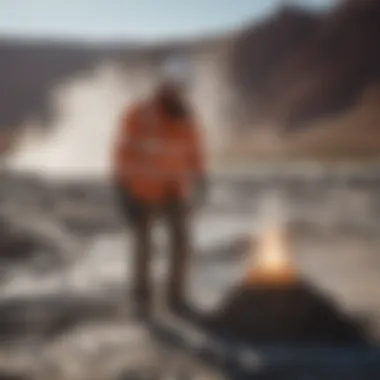Lithium Extraction from Geothermal Brine: Innovations


Intro
Lithium is emerging as a key material in the age of renewable energy and electric mobility. Its demand is surging, driven largely by the expanding market for lithium-ion batteries. These batteries power everything from smartphones to electric vehicles. Traditional lithium extraction methods, which mostly rely on mining hard rock or evaporating brine pools, have their share of environmental issues and limitations. In this context, extracting lithium from geothermal brine presents a novel approach. This method not only helps in resource recovery but also optimizes energy production from geothermal sources.
The process draws on the unique geological and chemical properties of geothermal brines, which are naturally occurring hot fluids trapped in the Earth's crust. As industries look for sustainable alternatives, the focus shifts towards identifying innovative methods that are both ecologically viable and economically feasible.
This narrative will cover the intricate details of lithium extraction from geothermal brine. We will start by examining the scientific problems this method addresses, along with its historical context. Following that, we will delve into key findings related to this extraction method, interpreting the implications these innovations hold for the future.
Prologue to Lithium and Its Importance
Lithium has gained significant attention in recent years due to its vital role in various applications, particularly in the context of renewable energy and technology advancements. As the demand for clean energy solutions increases, lithium has become a critical resource, primarily due to its application in lithium-ion batteries. These batteries power everything from electric vehicles to portable electronics, making lithium crucial to the transition towards a more sustainable future.
In the contemporary energy landscape, lithium not only serves as a power storage medium but also is integral in technological innovations aimed at improving energy efficiency. Its lightweight and high electrochemical potential make it an ideal candidate for advanced energy storage systems. Furthermore, lithium's unique properties position it as a key player in supporting electric mobility, a sector that has gained momentum in response to climate change concerns.
However, extracting lithium raises important considerations regarding environmental sustainability. Traditional mining practices contribute to ecological disruption and can lead to water scarcity in arid regions. This article will explore alternatives for lithium extraction, specifically focusing on geothermal brine as a sustainable source. This method combines energy production with resource recovery, allowing for a lower ecological footprint.
"The evolution of lithium extraction techniques needs to match the rise in technology demand, focusing on sustainable and environmentally friendly practices."
Understanding the implications of lithium extraction is crucial for policymakers, industry leaders, and researchers alike. It can not only inform strategies for resource management but also stimulate innovation in extraction technologies.
Overview of Lithium Applications
Lithium boasts a diverse range of applications across multiple industries, reflecting its versatility and importance. The most prominent applications include:
- Battery Production: Lithium-ion batteries dominate the market due to their efficiency, stability, and energy density.
- Ceramics and Glass: Lithium compounds are used in making high-strength glass and ceramics, improving thermal resistance and durability.
- Pharmaceuticals: Lithium salts are utilized in mood-stabilizing drugs, particularly for treating bipolar disorder.
- Alloys and Metallurgy: Lithium is employed in lightweight alloys that enhance structural strength in aerospace and automotive industries.
- Energy Storage Solutions: Beyond batteries, lithium plays a role in other energy storage systems that support renewable energy sources.
As industries continue to adopt renewable energy sources, the scope and demand for lithium are expected to expand further. With technological advancements, the efficiency of lithium usage will likely improve, potentially altering market dynamics and highlighting the importance of exploring sustainable extraction methods such as those from geothermal brine.
Understanding Geothermal Brine
Geothermal brine is crucial in the context of lithium extraction as it presents both opportunities and challenges. This naturally occurring resource is brine that originates from underground reservoirs of hot water and steam. The significance of understanding geothermal brine lies in its chemical composition and potential for lithium production.
Composition and Characteristics
The composition of geothermal brine is complex and varies greatly by location. Typically, it contains not only water and dissolved minerals but also significant concentrations of lithium, sodium, potassium, calcium, magnesium, and other trace elements.
- Lithium Concentrations: The lithium concentration in geothermal brine can range widely but is often found to be in the range of 100-500 mg/L. Such concentrations are promising for extraction processes.
- Temperature: The temperature of geothermal brine can exceed 200 °C, which is beneficial for enhancing the efficiency of lithium extraction methods. High temperatures can accelerate chemical reactions and improve the mobility of lithium ions.
- Salinity: Salting out occurs in brine solutions, impacting the efficiency of lithium recovery. Understanding salinity helps researchers to optimize separation processes.
Understanding these characteristics is paramount, as they directly influence the choice of extraction technologies and the overall efficiency of lithium recovery. By analyzing the composition of geothermal brine, companies can tailor their extraction methods for maximum yield.
Geothermal Systems and Their Locations
Geothermal systems capable of producing lithium-rich brines are found in various regions across the globe. Areas like the Salton Sea in California and parts of South America such as the Lithium Triangle (spanning Chile, Argentina, and Bolivia) are renowned for their geothermal potential.
- Salton Sea Basin: This area is known for having high geothermal activity and notable lithium concentrations in the brine. Ongoing projects aim to harness these resources for lithium production.
- Lithium Triangle: This region is characterized by a combination of high lithium brine concentrations, favorable geological conditions, and established infrastructure.
- Other Locations: Regions in Japan, Iceland, and Indonesia also show promise due to their geothermal resources.
The identification and understanding of these geographic locales allow industries to focus their resources effectively, fostering innovations in extraction technologies. With the growing demand for lithium, exploring unconventional sources, such as geothermal brine, is particularly important. As the world shifts towards more sustainable technologies, geothermal brine represents a viable pathway for lithium production.
"Geothermal brine extraction represents a dual opportunity: energy production and resource recovery. It is essential to comprehend the characteristics of brines to unlock their full potential."
The Process of Lithium Extraction from Geothermal Brine


The extraction of lithium from geothermal brine represents a intersection of renewable energy production and the burgeoning demand for lithium, which is critical for batteries and clean energy technologies. As the world shifts towards more sustainable practices, this method of resource recovery is gaining importance. The geothermal brine, often rich in lithium salts, offers an opportunity to extract lithium while concurrently generating energy. This dual-benefit aspect makes the process valuable in addressing both energy and resource requirements.
Extraction Techniques Overview
Several techniques exist for lithium extraction from geothermal brine, each with its own advantages and limitations. The most common methods include:
- Evaporation: This traditional technique utilizes solar energy to evaporate water from brines, concentrating the lithium content. While it is cost-effective, reliance on weather and climate conditions can lead to variability in production.
- Precipitation: By chemically altering the brine's composition, lithium can be precipitated out as lithium carbonate or lithium hydroxide. This method is effective in yielding high-purity lithium products but may involve complex chemical handling.
- Membrane Technology: Nano-filtration and reverse osmosis have emerged as modern solutions, enabling selective extraction of lithium ions. This method promises higher efficiency but can be expensive due to membrane replacement and maintenance costs.
These techniques are prominent in the industry, yet ongoing research is vital to improve efficiency and reduce costs.
Methodologies in Lithium Recovery
Diverse methodologies are being explored to enhance the yield of lithium recovery.
- Direct Lithium Extraction (DLE): Technology advancements have led to the emergence of DLE techniques that focus on minimizing water usage and maximizing lithium extraction speed. This method utilizes specific adsorbents that can selectively capture lithium ions from brine.
- Leaching: Employing lixiviants to leach out lithium from solid-state lithium-rich materials can be a supplementary approach. This technique is relevant for areas where brine quality may not suffice for efficient lithium extraction.
These methodologies necessitate careful evaluation of economic viability. It is crucial to balance recovery efficiency with environmental impact.
Recent Innovations in Technology
The landscape for lithium extraction from geothermal brine is evolving with innovative technologies.
- Advanced Sorbents: Recent developments in materials science have led to the creation of sorbents with improved selectivity for lithium ions, significantly increasing extraction rates. For instance, materials engineered at the molecular level show promise in capturing lithium more efficiently.
- Process Integration: New systems are being designed that integrate geothermal energy production with lithium extraction. This synergy not only optimizes overall system efficiency but also reduces waste by utilizing thermal energy in the extraction processes.
Technological advances are critical for meeting future demands. They have the potential to lower operation costs and improve the sustainability of lithium extraction from geothermal brine.
"The integration of geothermal processes with lithium extraction technology marks a significant step towards sustainable energy solutions."
In summary, the process of lithium extraction from geothermal brine is a multifaceted endeavor that combines traditional techniques with cutting-edge innovations. Understanding these extraction processes and methodologies is essential for researchers and industry players as they navigate the rapidly-changing landscape of lithium production.
Environmental Considerations
Environmental considerations play a crucial role in the lithium extraction process from geothermal brine. As societies increasingly focus on sustainability and eco-friendly practices, understanding these implications is vital. Analyzing how lithium extraction impacts geothermal resources provides insight into balancing resource recovery and environmental preservation.
Impact of Extraction on Geothermal Resources
The extraction of lithium from geothermal brine can affect the geothermal systems from which it is sourced. The primary concern is whether the extraction process might deplete these resources. Geothermal energy relies on the steady flow of hot water and steam from underground reservoirs. When lithium is extracted, it is essential to monitor the temperature and pressure of the geothermal reservoir.
There are several factors to consider:
- Resource Depletion: Excessive extraction may lead to reduced efficiency of geothermal systems, potentially lowering the long-term energy output.
- Thermal Stability: The temperature of the geothermal reservoir can decrease if extraction rates exceed the natural refill rates.
- Water Quality: Disturbances in the brine can affect the surrounding water quality, which has implications for local ecosystems.
To ensure environmental sustainability, operators must adopt careful management strategies. Implementing practices that emphasize maintaining equilibrium between lithium extraction and geothermal energy production can mitigate adverse effects.
"A responsible approach to lithium extraction can foster a sustainable future while meeting the growing demand for this essential resource."
Waste Management and Sustainability
The sustainability of lithium extraction from geothermal brine also hinges on effective waste management practices. The extraction process generates various types of waste, ranging from leftover brine to chemical byproducts. Understanding how to manage this waste is essential for environmental protection.
Key elements to address include:


- Brine Disposal: Brine leftover after lithium extraction often contains various minerals and chemicals. Proper disposal methods are critical to prevent contamination of local water sources.
- Byproducts Recycling: Some byproducts can potentially be reused in other applications, reducing waste and promoting a circular economy.
- Monitoring and Regulations: Compliance with environmental regulations is crucial. Regular monitoring of waste management practices is necessary to detect and rectify any environmental hazards promptly.
In summary, addressing environmental considerations is foundational in developing lithium extraction methods. Balancing the benefits of lithium as a clean energy source with the need to protect geothermal resources and ecosystems is essential for sustainability.
Economic Implications of Lithium Extraction
The economic ramifications of lithium extraction, especially from geothermal brine, are multifaceted. Understanding these implications is crucial for stakeholders, from investors to policymakers. Lithium has become a key commodity due to its role in energy storage solutions such as lithium-ion batteries. Its demand will likely continue to rise as the world shifts towards renewable energy sources and electric vehicles. Therefore, developing efficient and cost-effective lithium extraction methods can greatly impact the market.
Cost-Effectiveness of Geothermal Lithium
Cost-effectiveness is paramount in the extraction of lithium from geothermal brine due to the competitive nature of mineral resources. The evolving technology in the field has the potential to lower costs significantly. Several factors contribute to this.
- Energy Integration: Lithium extraction can occur alongside geothermal energy production, reducing operational costs. The process benefits from utilizing energy produced within the geothermal system.
- Reduced Water Use: Geothermal brine extraction typically uses less water compared to traditional lithium mining methods. With fresh water becoming a precious resource, this reduction can lower operational expenses and increase sustainability.
- By-product Recovery: Geothermal systems yield other elements like potassium. Extracting these additional valuable resources alongside lithium can disperse the costs of production, enhancing overall financial viability.
Studies show that the cost to extract lithium from geothermal brine can be competitive, especially when compared to extraction from hard rock or salars. Indeed, as this method becomes more widespread, prices might stabilize or even decrease, contributing to the economic sustainability of lithium use in modern technologies.
Market Demand and Pricing Trends
Market demand for lithium has surged due to several converging factors. The push towards electric vehicles and renewable energy systems fuels this growth. Not only are manufactures increasing their production capabilities, but consumers are also changing their preferences towards more efficient energy solutions. Economic implications of this trend are significant.
- Increasing Prices: As demand grows, the price of lithium has increased, reflecting market dynamics. In recent years, lithium prices have shown strong volatility based on global demand, with spikes correlating to increased electric vehicle production.
- Forecasting Demand: Analysts predict significant growth in the lithium market in the coming decade. This projection impacts investment into extraction technologies, with companies aiming to secure future supplies.
- Global Competition: Countries rich in lithium resources are beginning to experience heightened competition for production. This competition can influence pricing dynamics and ultimately affect which technologies gain traction internationally.
Ultimately, the intricate dynamics of the lithium market and its pricing trends underscore the financial size of opportunities in geothermal brine extraction.
In summary, economic implications surrounding lithium extraction from geothermal brine necessitate careful consideration. Companies must focus on cost-effective methodologies and keep a close eye on market demand and pricing trends. By doing so, they can not only remain profitable but also contribute to a sustainable energy future.
Case Studies in Lithium Extraction from Geothermal Brine
Importance of Case Studies in Lithium Extraction from Geothermal Brine
Case studies in lithium extraction from geothermal brine are critical for understanding the practical application of theoretical concepts discussed in earlier sections. They provide real-world examples of how essential technologies are deployed, and their outcomes inform future advancements. These case studies serve several purposes, including validating extraction methods and exploring the challenges encountered during implementation. Furthermore, they showcase successful practices that can be replicated in different geographical and technical conditions. This evidence-based approach enhances the credibility of lithium extraction as a sustainable resource and adds depth to the dialogue surrounding its economic viability.
Successful Implementations Worldwide
The global landscape for lithium extraction from geothermal brine features several noteworthy implementations. A prominent example is the Salton Sea geothermal field in California. This site has attracted significant attention due to its rich geothermal resources and high lithium concentrations. The local utility, CalEnergy, alongside several technology firms, has initiated projects where lithium is extracted efficiently while producing energy for the grid.
Another significant case is in Iceland, where Geothermal Power Plant utilizes geothermal brine for lithium extraction. The country's access to geothermal energy has facilitated the development of methods that integrate resource recovery with renewable energy production. Both examples illustrate how diverse methodologies can lead to productive outcomes and demonstrate the potential for scaling these operations worldwide.
Lessons Learned from Existing Projects
Existing projects have yielded valuable insights that can be applied to future ventures. First, scaling up extraction technology demands a multidisciplinary approach. Engineers, scientists, and environmentalists must collaborate to address technical challenges while considering environmental impacts. For instance, the Salton Sea project has faced community concerns about the environmental footprint of lithium extraction, emphasizing the importance of transparency and stakeholder engagement.
Second, adaptability in technologies is key. Lithium extraction processes must be customized to specific geothermal conditions and brine compositions. This adaptability was evident in the various methodologies employed in Iceland, allowing for efficient lithium recovery under different geological circumstances. Learning from such implementations can guide new projects in optimizing resource extraction without compromising sustainability.
Successful case studies not only showcase technical achievements but also clarify economic and social implications, leading to more informed decision-making.
Future Prospects in Lithium Extraction
The future of lithium extraction from geothermal brine holds significant promise. This method offers a dual benefit by harnessing geothermal resources while simultaneously extracting valuable lithium. Given the increasing demand for lithium in batteries for electric vehicles and renewable energy storage, it is crucial to develop sustainable and efficient extraction methods. The integration of new technologies and supportive policies will play a vital role in shaping this future.
Technological Advancements on the Horizon


Recent years have witnessed remarkable advancements in extraction technologies. Innovations such as direct lithium extraction methods show great potential. These methods can improve the efficiency of lithium recovery by increasing yield while reducing costs and environmental footprint. Techniques like solvent extraction, membrane filtration, and ion exchange are being refined. Researchers are also exploring lithium-selective ion-exchange membranes, which could enhance the speed of extraction significantly.
- Direct Extraction Methods
- Improved Processing Techniques
- Employing innovative materials for enhanced selectivity.
- Minimizing waste products during extraction.
- Integration of automation and data analytics for performance optimization.
- Use of advanced sensors for real-time monitoring of lithium concentration.
These technological improvements not only aim at increasing extraction efficiency but also at ensuring scalability, which is paramount when considering large-scale production. The successful implementation of these advancements can revolutionize the lithium market.
Policy and Regulatory Frameworks
The establishment of supportive policy frameworks is essential for the advancement of lithium extraction from geothermal brine. Governments and regulatory bodies will need to design policies that incentivize eco-friendly practices. This includes granting permits for geothermal projects that prioritize lithium extraction. Moreover, regulations must be flexible enough to accommodate technological improvements over time.
- Government Incentives
- Sustainability Standards
- Tax breaks for companies investing in sustainable lithium extraction technologies.
- Financial support for research and development initiatives in this area.
- Setting clear guidelines on environmental impacts to protect geothermal resources.
- Implementation of best practices for waste management during the extraction process.
It is crucial for policymakers to work collaboratively with the scientific community to foster an environment that promotes innovation.
As the demand for lithium continues to rise, strategic partnerships among stakeholders will be pivotal. By aligning technological efforts with sound policies, the future prospects in lithium extraction can be enhanced, ultimately resulting in a more sustainable approach to harnessing this essential resource.
Challenges in Scaling Up Extraction Techniques
The topic of scaling up lithium extraction from geothermal brine is paramount. As the world shifts towards greener technologies and electric vehicles, the demand for lithium is surging. However, scaling up the extraction process involves various complexities. It is not just about increasing production volumes but also ensuring that this is done in an eco-friendly and economically feasible manner.
Effective extraction techniques must be honed and adapted for broader implementation. Energy efficiency plays a crucial role in this, as does the need to minimize environmental impacts. These challenges must be addressed to make lithium extraction a more sustainable practice, ultimately supporting a cleaner energy future.
Technical Barriers to Large-Scale Implementation
One of the primary technical hurdles lies in the varied composition and chemistry of geothermal brines. Each geothermal system presents unique challenges due to differences in mineral content and temperature. This affects the efficiency of existing extraction techniques.
Current methods may require modifications to work optimally across various sites. Developing flexible technologies that can adapt to different geothermal conditions is key. Additionally, many technologies still rely on conventional resource extraction practices, which may not be scalable or sustainable in the long term.
The infrastructure required for large-scale operations also presents challenges. Pipelines, processing plants, and transportation logistics need to be established to handle increased production levels. This creates an additional layer of complexity and requires substantial investments in technology and resources.
Economic and Market Resistance
The financial aspect is another significant barrier. The costs associated with developing, implementing, and maintaining new extraction technologies are high. Many companies may hesitate to invest heavily when immediate returns are not guaranteed. This leads to a cautious approach in adopting innovative methods.
Moreover, market dynamics can influence the willingness of stakeholders to invest. For example, price fluctuations in lithium can lead investors to retreat from projects that require long-term capital commitment. This market resistance complicates efforts to transition from small-scale to larger operations.
In addition, regulatory and policy environments can impact economic viability. Clear guidelines and incentives for geothermal energy projects could ease financial burdens and encourage investments. However, without supportive measures, market growth may be stunted, preventing the broader adoption of these promising technologies.
Ending
The conclusion of this article highlights the significance of lithium extraction from geothermal brine. As the global demand for lithium continues to rise due to its essential role in batteries for electric vehicles and renewable energy storage, it is imperative to explore sustainable and efficient extraction methods. This article underscores the innovations in extraction technologies and the positive implications for both energy production and resource recovery.
Summary of Key Points
The discussion throughout this article addressed several key aspects:
- The importance of lithium in various applications, particularly in energy transition and electrification.
- The unique properties and potential of geothermal brines as a source of lithium.
- A variety of extraction techniques, including novel methodologies that improve recovery rates and efficiency,while minimizing environmental impact.
- Economic implications, showing that geothermal lithium extraction may offer a cost-effective alternative in the growing lithium market.
- Various case studies illustrating successful implementations worldwide, revealing lessons that can be applied in future projects.
- A look into the future, focusing on potential challenges and technological advancements that could further enhance extraction processes.
Final Thoughts on the Future of Lithium Extraction
Looking ahead, the future of lithium extraction from geothermal brine appears promising yet complex. As researchers continue to develop more efficient extraction methods, it becomes crucial to balance economic viability with environmental sustainability. The collaboration between industry stakeholders, governments, and research institutions will be essential to overcome technical barriers and scale up operations. Additionally, policy frameworks will need to adapt to the evolving landscape of lithium demand.







